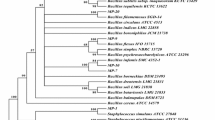Summary
Raw and cured compost samples from a large-scale urban composter were studied over a period of eight months to gain information on bacterial species present. Total viable, aerobic heterotrophic bacteria, lactose-positive bacteria, antibiotic and metal-resistant bacteria and thermophilic bacteria were enumerated. Both raw and cured compost samples contained metal and antibiotic-tolerant bacteria (<Log 3.0 to Log 8.5 CFU g−1 compost) as well as high numbers (as high as Log 7.4 CFU g−1 dry weight compost) of thermophilic bacteria isolated by growth at 55 °C. Selected colonies were also identified using the Biolog 95 substrate identification system.Escherichia coli andSalmonella spp. were not detected in compost samples.
Similar content being viewed by others
References
Bagstram, G. 1978. Population changes in microorganisms during composting of sprucebark: I. Influence of temperature control. Eur. J. Appl. Microbiol. Biotechnol. 5: 315–330.
Berkeley, R.C.W., N.A. Logan, L.A. Shute and A.G. Capey. 1984. Identification ofBacillus species. In: Methods in Microbiology Vol. 16 (Tergan, T., ed.), pp. 291–328, Academic Press, New York.
Bollen, G.J. 1985. Lethal temperatures of soil fungi. In: Ecology and Management of Soil-borne Pathogens (Parker, C.A., A.D. Rovira, K.R. Moore and P.T.W. Wong, eds) pp. 191–193, APS, St Paul, Minnesota.
Bollen, G.J., D. Volker and A.P. Wijnen. 1989. Inactivation of soil-borne plant pathogens during small-scale composting of crop residues. Neth. J. Pl. Pathol. 95 (Supplement I): 19–30.
Collins, C.H. and D.A. Kennedy. 1992. The microbiological hazards of municipal and clinical wastes. J. Appl. Microbiol. 73: 1–6.
Finstein, M.S., K. Wei-Ru Lin and G.E. Fischer. 1982. Sludge composting and utilization: review of the literature on temperature inactivation of pathogens. Report, New Jersey Agricultural Experiment Station, Rutgers University, New Brunswick.
Hardy, G.E. and St. J. Sivasithamparam. 1989. Microbial, chemical and physical changes during the composting of a eucalyptus (Eucalyptus calophylla andEucalyptus diversicolor) bark mix. Biol. Fert. Soils 8: 260–270.
Hoitink, H.A.J., L.J. Herr and A.F. Schmitthenner. 1976. Survival of some plant pathogens during composting of hardwood tree bark. Phytopathol. 66: 1369–1372.
Hussong, D., W.D. Burge and N.K. Enkiri. 1985. Occurrence, growth and suppression of salmonellae in composted sewage sludge. Appl. Environ. Microbiol. 50: 887–893.
Van Dyke, M.I., P. Couture, M. Brauer, H. Lee and J.T. Trevors. 1993. Structural characterization ofPseudomonas aeruginosa UG2 rhamnolipid biosurfactants and their use in removing hydrophobic compounds from soil. Can. J. Microbiol. 39: 1071–1078.
Wiley, B.B. and S.C. Westerberg. 1969. Survival of human pathogens in composted sewage. Appl. Microbiol. 18: 994–1001.
Yuen, G.Y. and R.D. Raabe. 1984. Effects of small-scale aerobic composting on survival of some fungal plant pathogens. Plant Dis. 68: 134–136.
Author information
Authors and Affiliations
Rights and permissions
About this article
Cite this article
Andrews, S.A., Lee, H. & Trevors, J.T. Bacterial species in raw and cured compost from a large-scale urban composter. Journal of Industrial Microbiology 13, 177–182 (1994). https://doi.org/10.1007/BF01584004
Received:
Accepted:
Issue Date:
DOI: https://doi.org/10.1007/BF01584004




